Physical Address
304 North Cardinal St.
Dorchester Center, MA 02124
Physical Address
304 North Cardinal St.
Dorchester Center, MA 02124
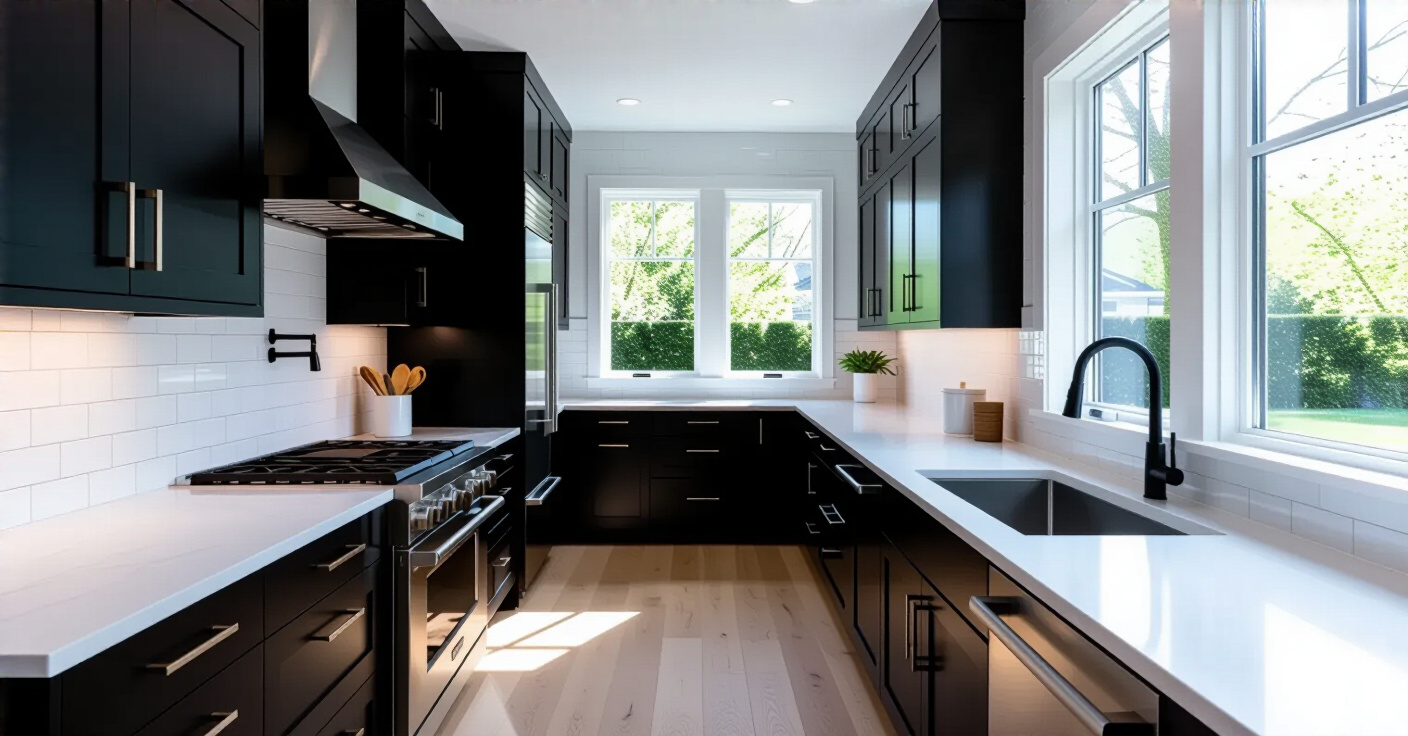
Think black kitchen cabinets aren't for families? Think again! Sofia's 19 expert tips show you how to create a stylish, durable, and kid-friendly black kitchen.
You know what people always ask me? They see these gorgeous, dramatic black kitchens on Pinterest and say, “Sofia, I love this, but I have kids. Can I really do this?” They imagine a dark, moody cave covered in sticky fingerprints and immediately dismiss it as a look for child-free minimalists.
And I used to think the same thing! Then I started looking at it through my early childhood education lens. A child’s environment is their third teacher, right? It can either support them or work against them. I realized a black kitchen, done wrong, could feel like a cave. But done right? It can be an incredible backdrop for family life. It can feel grounded, cozy, and surprisingly practical. It’s all about creating balance, texture, and light—the very same principles I use when designing a playroom.
The secret isn’t avoiding black. It’s about knowing which battles to fight and where to find the shortcuts. The stuff that actually matters is choosing the right finish and layering in warmth. The noise? Fretting about every single smudge. There’s a way to design this so you’re not constantly wiping things down. So, let’s talk about how to make a bold, beautiful black kitchen that works for the whole family, happy chaos and all.
Before you even think about ordering a cabinet, we have to lay the groundwork. This is the part that feels a little like homework, but I promise it’s what separates a “wow” kitchen from a “whoa, that’s dark” kitchen. It’s all about thinking how your family will actually use and feel in the space, turning your bold vision into a warm, welcoming reality.
Think of your kitchen like a houseplant. A dark one needs even more light to thrive. Before you commit to black, you need to become a bit of a sun detective. Black surfaces drink up light like a sponge, and if you don’t have enough natural light coming in, your beautiful, sophisticated kitchen can start to feel like a gloomy, unwelcoming cave. And let’s be honest, no one, especially not a child, wants to hang out in a cave.
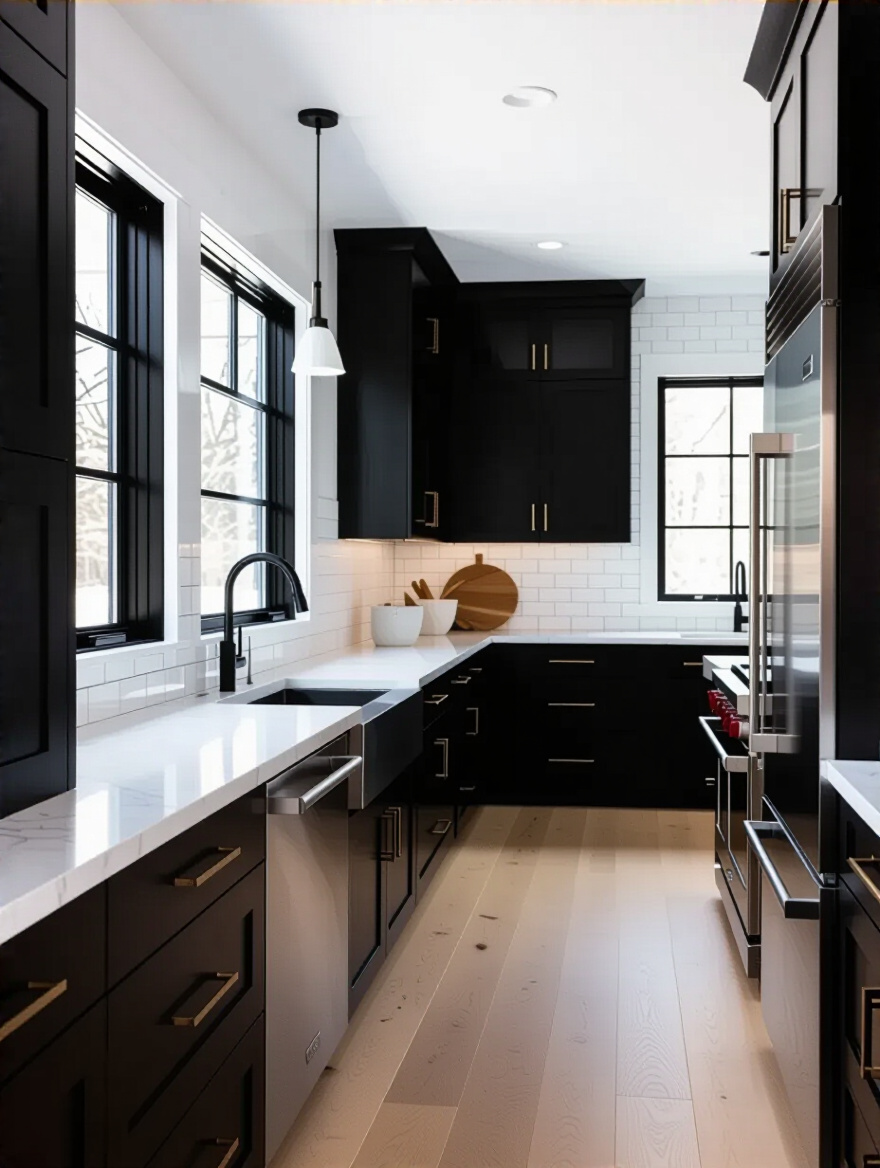
My shortcut? Do a “Sunlight Scavenger Hunt.” Spend a day—a sunny one and a cloudy one if you can—just noticing where the light lands. Which corners stay dark? Where does it feel bright and happy? This isn’t just about avoiding a dark room; it’s about boosting everyone’s mood. More light literally makes a space feel bigger, happier, and more energetic. It ensures your gorgeous black cabinets look rich and intentional, not just heavy.
Okay, you’ve assessed your light. Now comes the single most important decision for any family considering a black kitchen…
Can we talk about the biggest piece of BS everyone says about black cabinets? They say, “Get glossy, it’s so easy to wipe clean!” And technically, yes, a sticky smear will wipe off a glossy surface easily. But what they don’t tell you is that a high-gloss black cabinet is basically a high-definition mirror for every single fingerprint, smudge, and speck of dust in a five-mile radius. It’s a full-time job keeping it looking perfect.
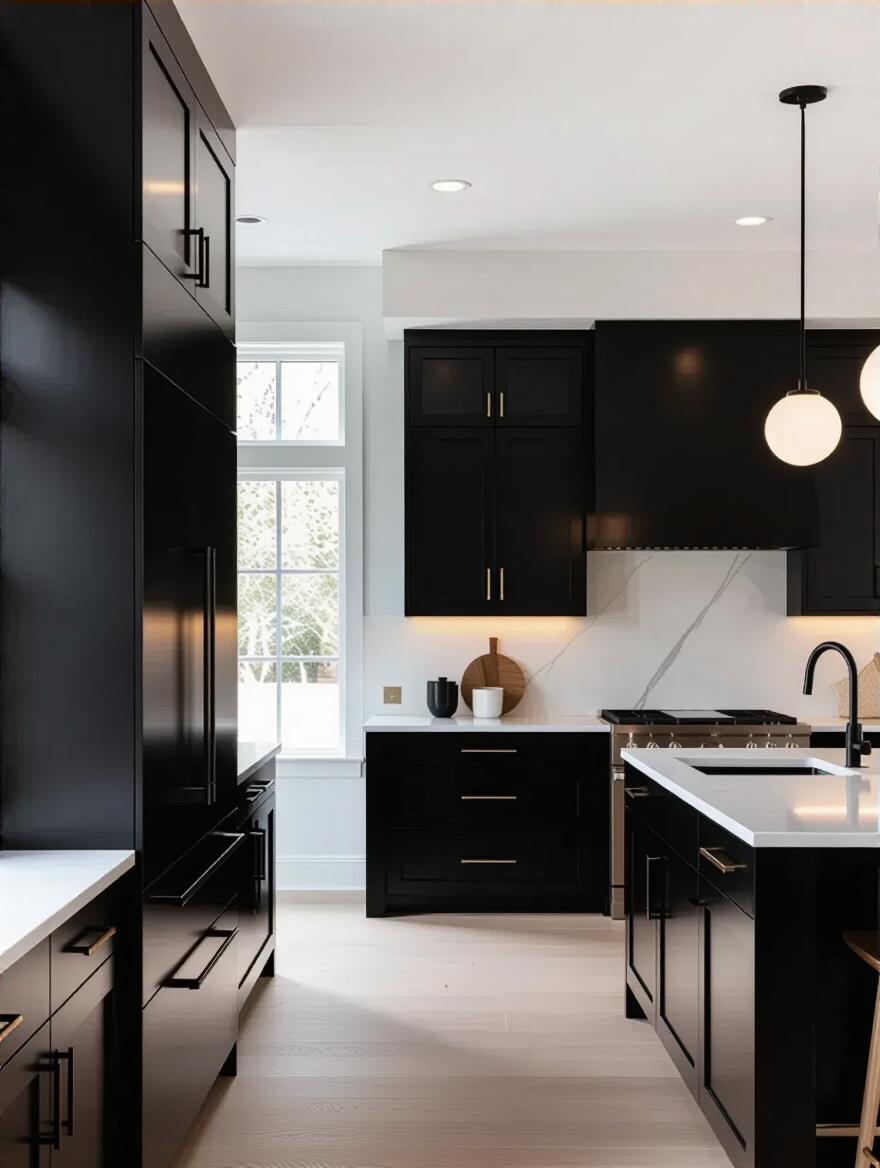
If you have kids, pets, or just enjoy your sanity, a matte finish is your superhero. Matte surfaces diffuse light instead of reflecting it, which means they are incredibly forgiving. They have a soft, velvety look that hides minor smudges and fingerprints like a champ. I had a client with twin toddlers who insisted on high-gloss black lowers. A week after installation, she called me in a panic. Her beautiful new kitchen looked like a crime scene. We ended up swapping the doors for a super-matte finish, and it changed everything. It still looked incredibly chic, but she wasn’t on her hands and knees wiping them every ten minutes.
Now that we’ve got our finish sorted, let’s look down. The floor is the foundation that holds the whole look together.
Your floor isn’t just something you walk on; it’s the stage for your dramatic black cabinets. If you pair black cabinets with a dark floor, you’re basically creating a black hole that sucks all the light and energy out of the room. It can make the whole space feel heavy and smaller than it is. The trick is to go light.
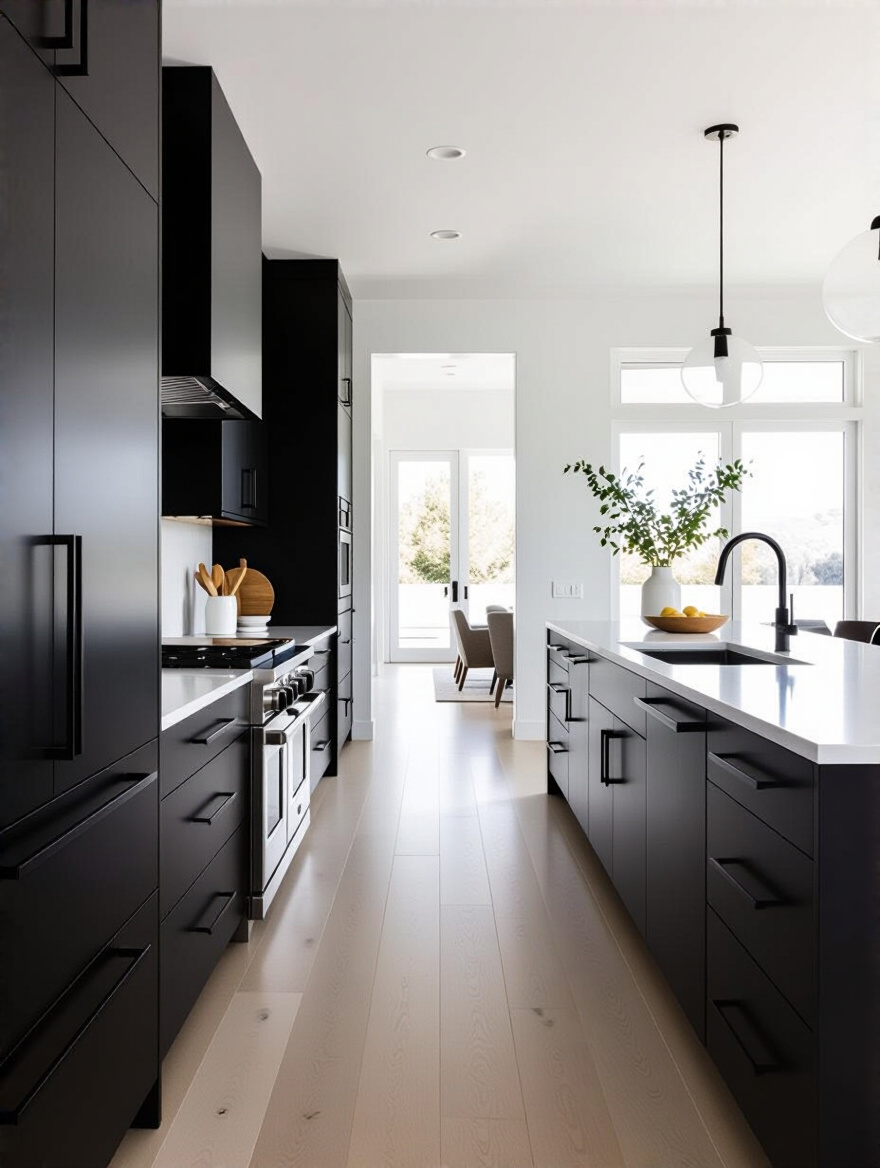
Think of it this way: a lighter floor—like a natural white oak, a light gray tile, or even a polished concrete—acts like a giant reflector. It bounces light back up into the room, making everything feel brighter and airier. It creates a beautiful, crisp contrast that makes your black cabinets pop and look intentional, like a piece of modern art. A light floor also provides that crucial visual break, grounding the space so the black doesn’t feel overwhelming.
With the floor as our stage, it’s time to choose the main actors: the cabinet doors themselves.
Black is already a huge statement. You don’t need a fussy, overly detailed cabinet style on top of that. In a family kitchen, simplicity is your friend for two reasons: aesthetics and cleaning. The more grooves, bevels, and details a cabinet door has, the more places there are for crumbs, dust, and mysterious sticky stuff to hide.
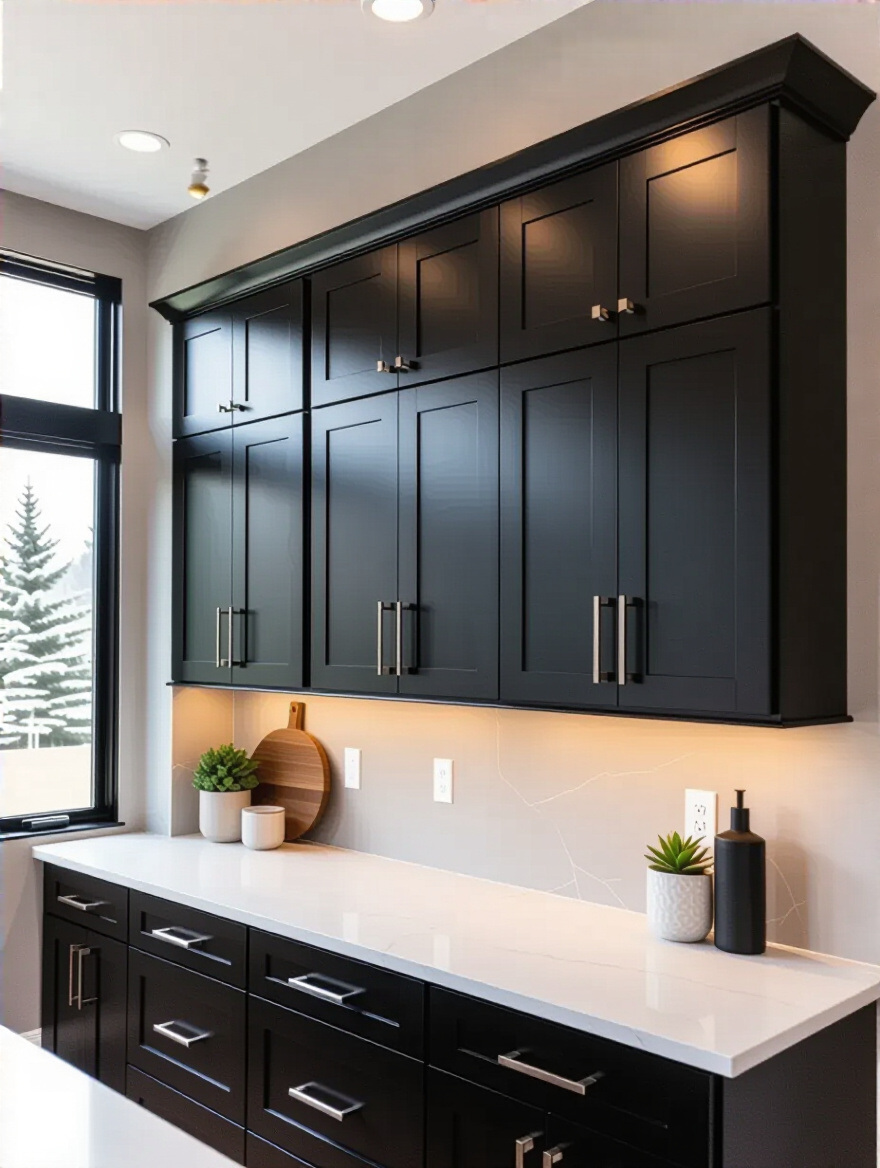
For a family home, a flat-panel (or slab) door is the ultimate easy-to-clean hero. One smooth surface, one quick wipe, and you’re done. It gives you a super sleek, modern look. If that feels a little too stark, the classic Shaker style is your next best bet. Its clean lines are timeless and versatile, and it has far fewer nooks and crannies than a traditional raised-panel door. My rule of thumb: if you can’t clean the door profile with a single swipe of a cloth, it’s going to annoy you later.
Finally, let’s wrap the room in a color that makes it feel open and bright.
When you have something as bold as black cabinets, your walls need to be the supporting actor, not the star. Think of your walls as the “breathing space” for the room. Their job is to create balance and reflect light to prevent those beautiful black cabinets from feeling like they’re closing in on you. The easiest way to do this is with white.

But not just any white! Pick a white that complements the undertones of your black. A crisp, cool white works wonders with a true, jet black for a modern, high-contrast look. If your black is a bit softer, like a charcoal, a warmer off-white can create a cozier, more inviting vibe. A pro tip is to paint the ceiling the same light color. It draws the eye upward and makes the entire room feel taller and more spacious. It’s a simple trick that has a huge psychological impact.
Okay, we’ve poured the foundation and put up the walls. The kitchen has good bones! Now it’s time for the fun part—adding the layers of personality and polish. This is where we bring in the “jewelry” and textures that will take your kitchen from simply “black” to breathtakingly beautiful.
Your countertop is the biggest horizontal surface in your kitchen, and it has to work hard. With black cabinets, you have an opportunity to create a stunning contrast, but with a family, you also need something practically indestructible. My confession: while I adore the look of natural marble, I would almost never recommend it for a family kitchen with dark cabinets. It’s porous, it stains, and it will break your heart the first time someone spills grape juice on it.
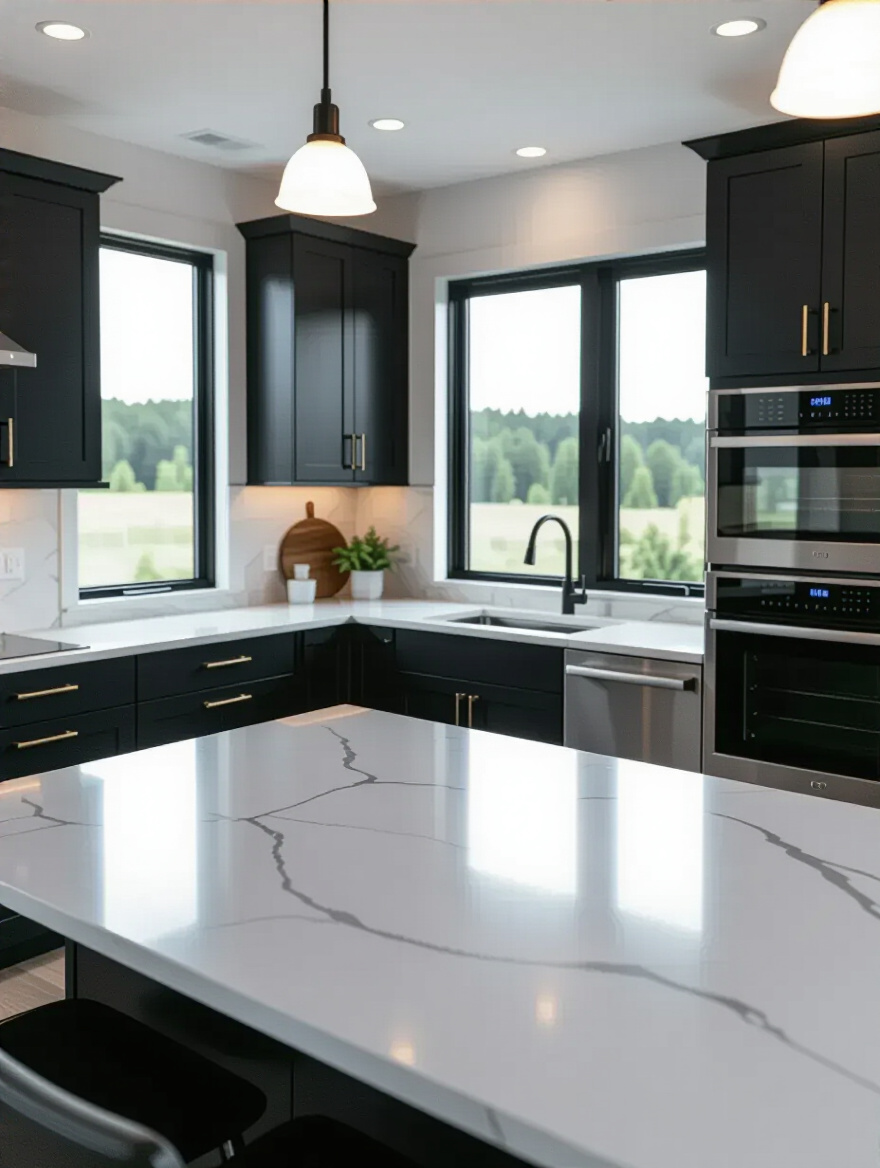
Your best friend here is quartz. It’s an engineered stone that is non-porous, stain-resistant, scratch-resistant, and comes in a million beautiful patterns. A white or light-gray quartz with subtle veining gives you the luxe look of marble without the high-maintenance relationship. It will beautifully break up the black, bounce light all over the room, and stand up to whatever your kids throw at it (literally). It’s the ultimate shortcut to getting both style and peace of mind.
Just behind the countertop is your chance to add a splash of personality.
If the countertops are the workhorse, the backsplash is the playground. This is your prime opportunity to inject some texture, pattern, or even color into your sophisticated black kitchen. Against a dark, uniform backdrop, even a simple white subway tile looks incredibly graphic and crisp. It’s a classic for a reason: it’s affordable, easy to clean, and reflects a ton of light right where you need it most.
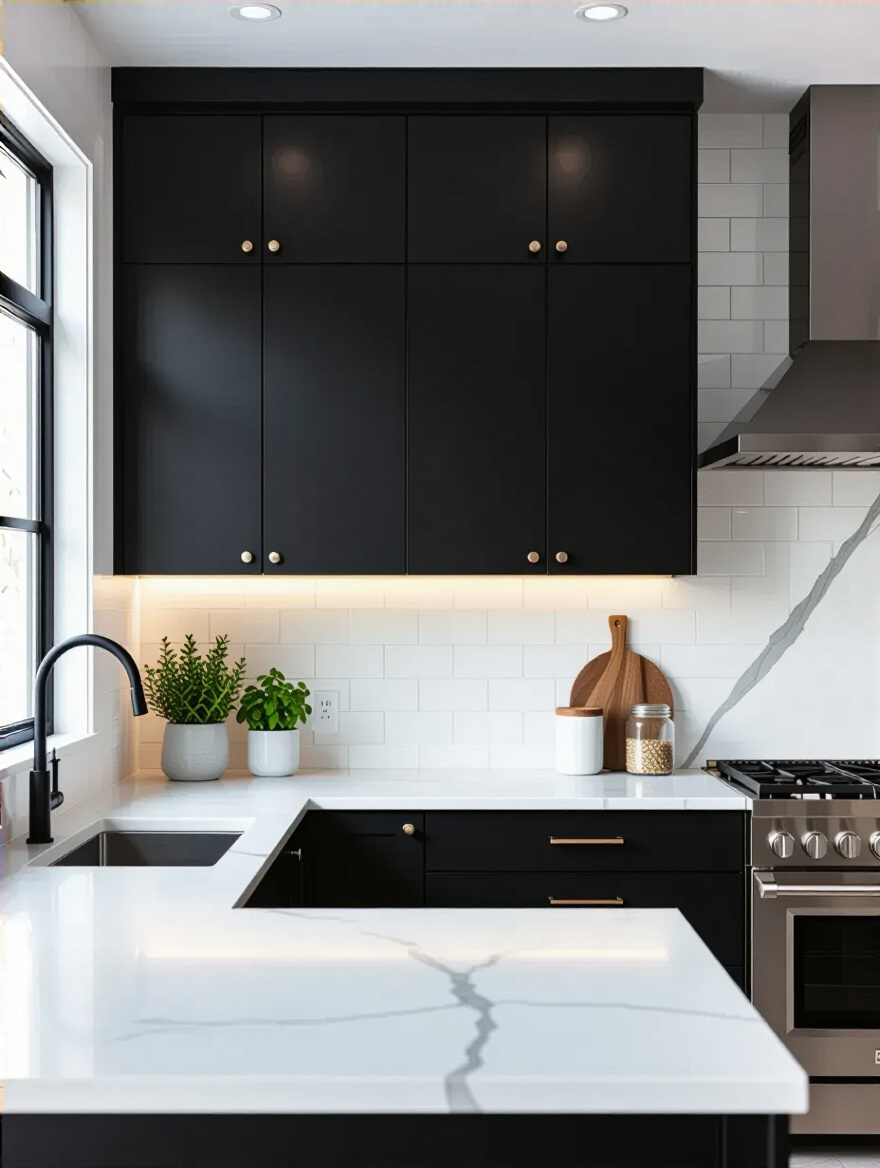
But don’t be afraid to have a little fun here! A beautiful handmade Zellige tile can add a shimmery, organic texture. A backsplash with a subtle geometric pattern can create a stunning focal point without overwhelming the space. The key is to create contrast. This visual break is what stops the black from feeling like a solid block and adds that crucial layer of depth and interest. My advice? Get samples and prop them up. See how they catch the light throughout the day before you commit.
Now let’s talk about the jewelry of the kitchen—the hardware.
Hardware is such a powerful tool in a black kitchen. It’s a chance to introduce a different material and finish, and the contrast is so much more dramatic against a black backdrop. A warm brushed brass or gold pull instantly adds a layer of warmth and luxury. Polished chrome or nickel gives a crisp, classic feel. Even matte black hardware on a matte black cabinet can create a super-sleek, textural look.
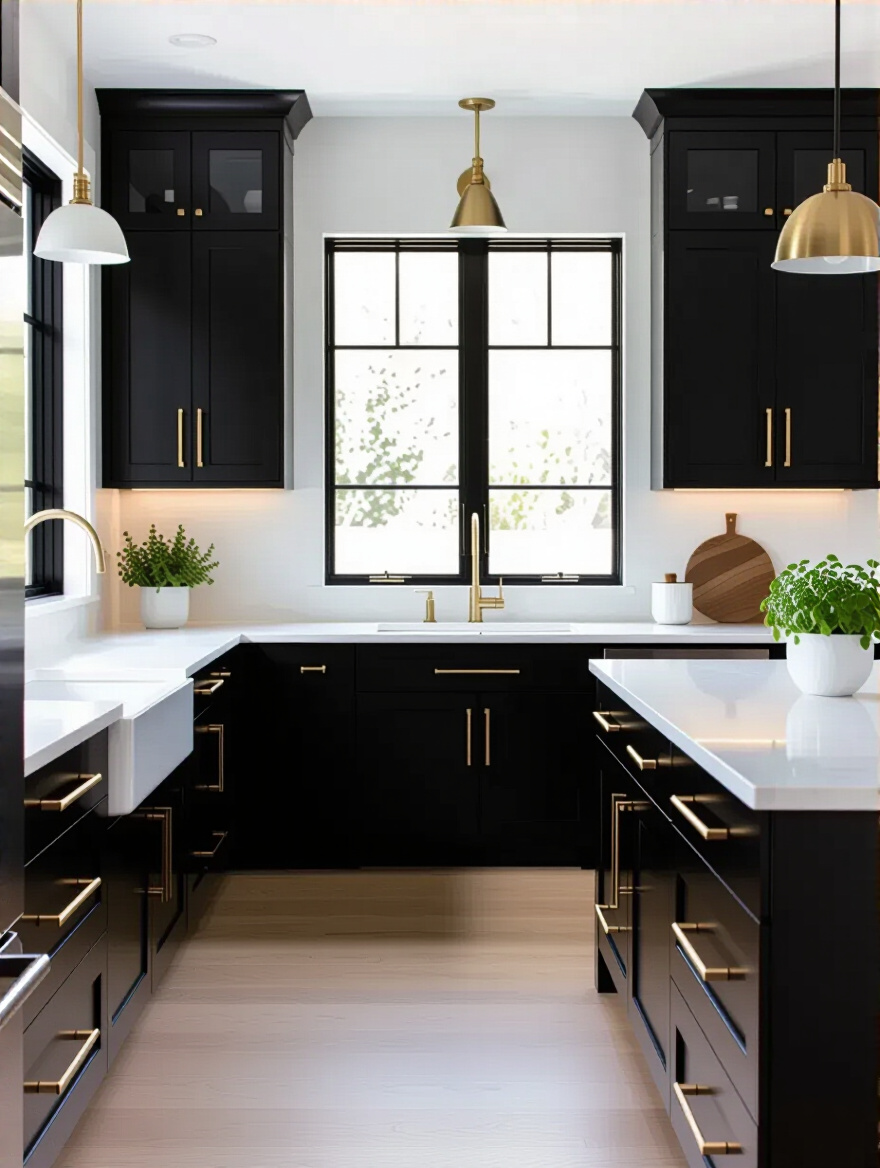
But beyond just looks, think about ergonomics, especially with little hands in the house.
“I always have clients actually hold the hardware samples. Can you comfortably get your fingers around it? Does it have sharp edges that could snag clothing? Is it easy for a child to grab to open their designated snack drawer?”
Hardware is a tactile part of your kitchen that you’ll be touching every single day. Make sure it feels good, is proportional to your cabinet size, and truly serves the style you’re trying to create.
To keep the space from feeling too cold or modern, we need to add a dose of nature.
Here’s a shortcut I wish I knew earlier: if your black kitchen is feeling a little sterile or cold, the answer is almost always wood. Natural wood accents are the secret ingredient that infuses warmth, texture, and a sense of history into the space. It’s the perfect organic counterpoint to the sleek, man-made feel of black cabinets.

This doesn’t mean you need to go full-on rustic. It can be as simple as some beautiful floating shelves in a warm white oak, a set of wooden barstools at the island, or even just a collection of thick wooden cutting boards leaning against the backsplash. These elements break up the black, soften the hard lines, and make the entire room feel more grounded and inviting. It’s a key principle of biophilic design—connecting our spaces to nature makes us feel calmer and happier.
Now let’s add a little bit of glitz and glam to make the whole room shine.
Think of metallic finishes as the little sparks of light that dance around the room. In a black kitchen, they are essential for reflecting light and adding a layer of sophisticated glamor. And we’re not just talking about hardware. A beautiful gooseneck faucet in a brushed bronze, a trio of pendant lights with a warm gold interior over the island, or even the stainless steel trim on your appliances can all contribute.
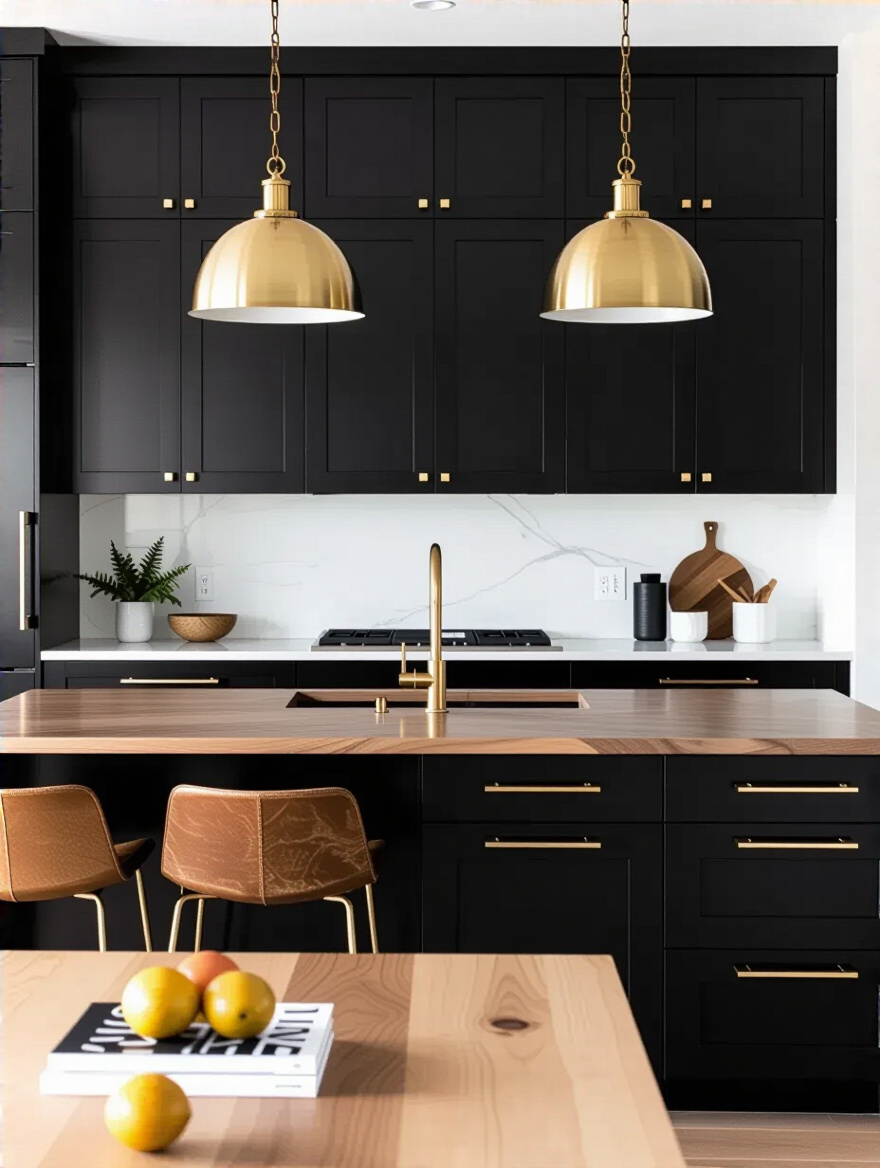
The trick is to be consistent. Don’t go crazy mixing five different metals. Pick one or two primary finishes to create a cohesive story. For example, you could pair brushed brass hardware with a matte black faucet for a chic, mixed-metal look. Or stick with polished nickel for everything to create a bright, classic vibe. These little hints of shine prevent the black from feeling flat and one-dimensional.
And now for the most classic, can’t-go-wrong pairing of all time.
There is nothing more timeless and dynamic than a black and white color palette. In a kitchen, using crisp white elements is the most powerful tool you have to balance the weight of black cabinets. The high contrast is instantly dramatic and chic, and the white surfaces work overtime to bounce light around, making the entire space feel brighter and more expansive.
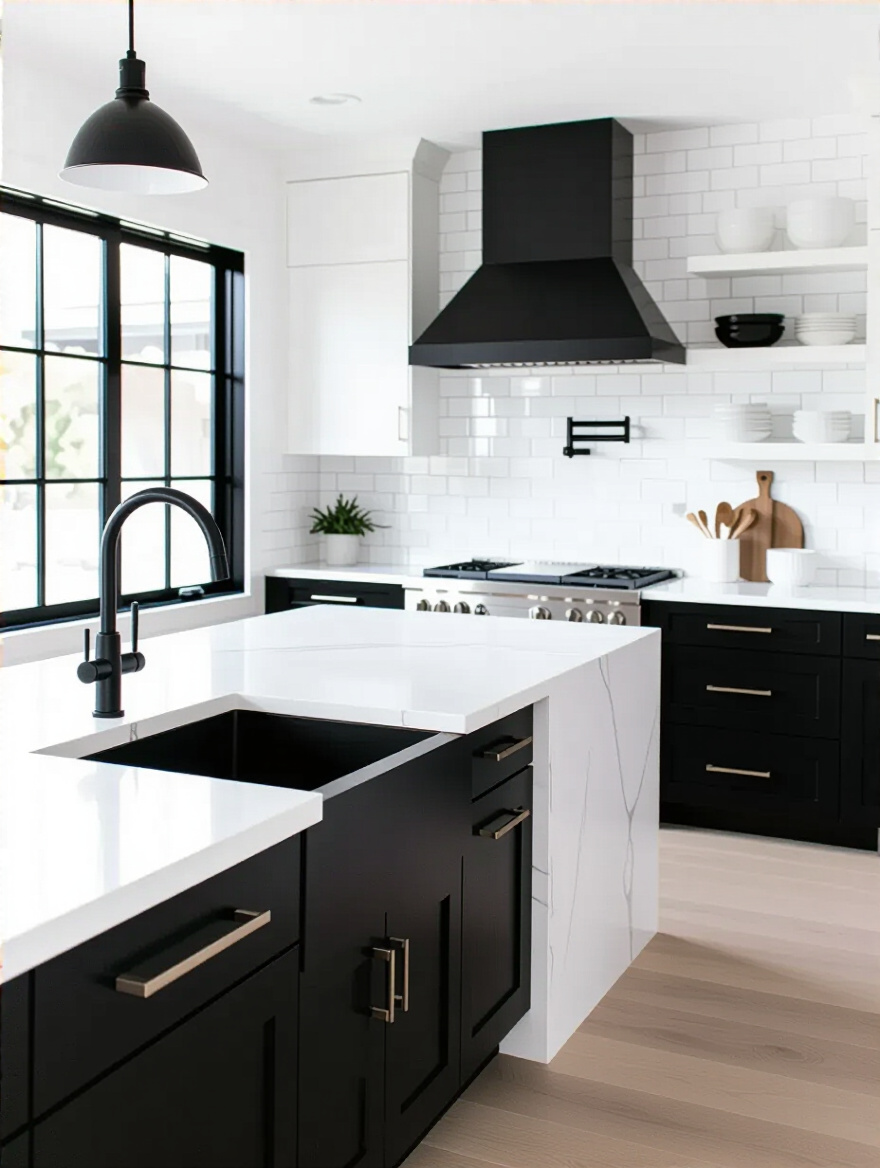
The most effective way to do this is with white countertops and a white backsplash, creating a brilliant, light-filled work zone sandwiched between black cabinets. You could also do black lower cabinets with white uppers for a lighter feel, or have a stunning white island that acts as the bright, glowing center of the room. The push-and-pull between the black and white creates an energy and a rhythm that is just so satisfying and will truly never go out of style.
Alright, you’ve designed a stunning kitchen. It’s a masterpiece. Now, how do you actually live in it without dedicating your life to cleaning? This is where a little bit of “defensive design” and some smart routines come in. The goal is to make upkeep feel effortless, so you can spend more time enjoying your beautiful space.
We already talked about choosing a matte finish, which is your first line of defense against fingerprints. Your second is hardware. Make it a family rule: we use the handles and pulls, not the cabinet face! This alone will cut down on 90% of the smudges.
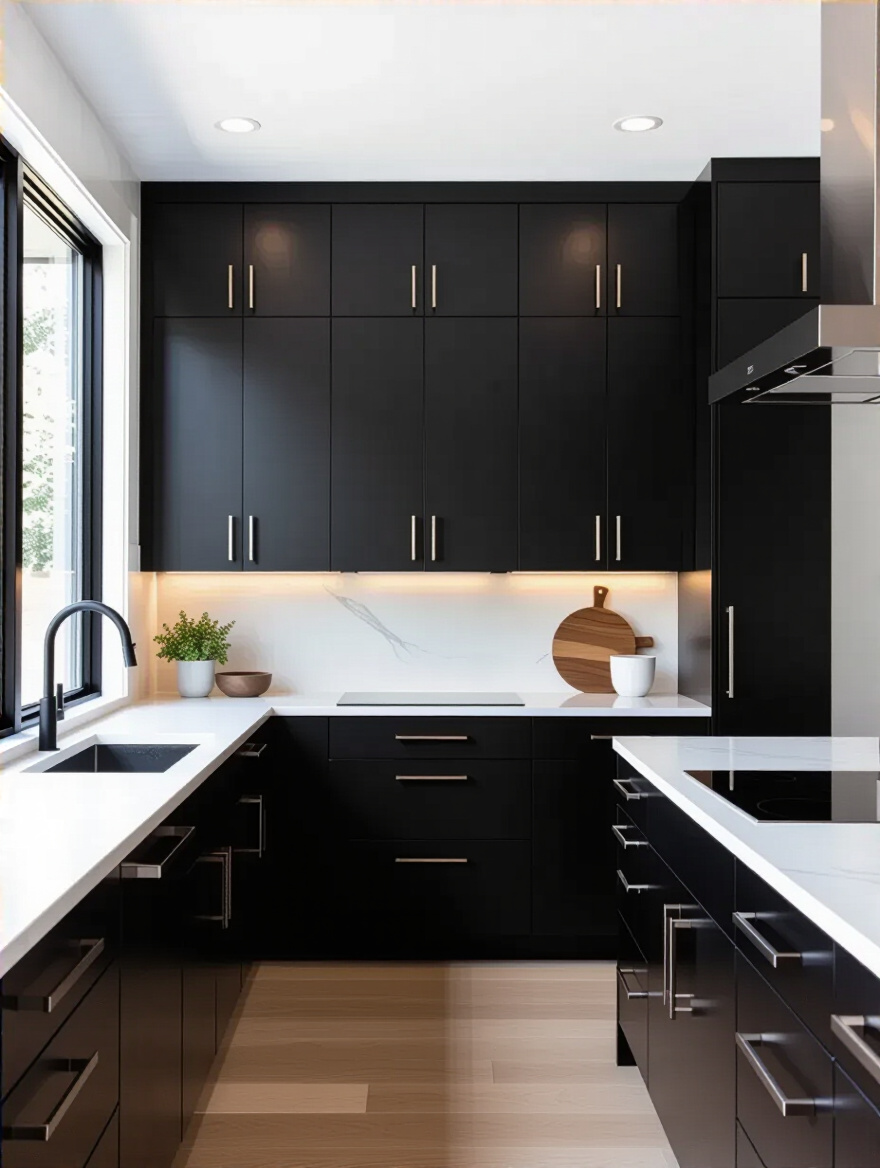
For the inevitable stray prints, your secret weapon isn’t a fancy spray—it’s a good, dry microfiber cloth. A quick, gentle wipe is usually all it takes to make them disappear. You can also look into specialized anti-fingerprint finishes, like FENIX, which are amazing but come at a higher price point. For most families, a matte finish and good habits are all you need to keep things looking pristine without driving yourself crazy.
When smudges do happen, having a simple, go-to cleaning method is key.
The biggest mistake people make when cleaning black cabinets is using a wet cloth and then just letting it air dry. That’s a one-way ticket to a streaky, cloudy finish, especially if you have hard water. The key to a perfect, streak-free shine is all in the drying step.

Here’s the only routine you’ll ever need:
Beyond cleaning, a little proactive protection goes a long way.
Scratches and dings are just a part of life in a busy home, but on a black cabinet, a little nick can look like a giant gash because of the high contrast. My best advice? Order a manufacturer-matched touch-up pen or kit the same day you order your cabinets. Keep it somewhere handy, like the junk drawer.
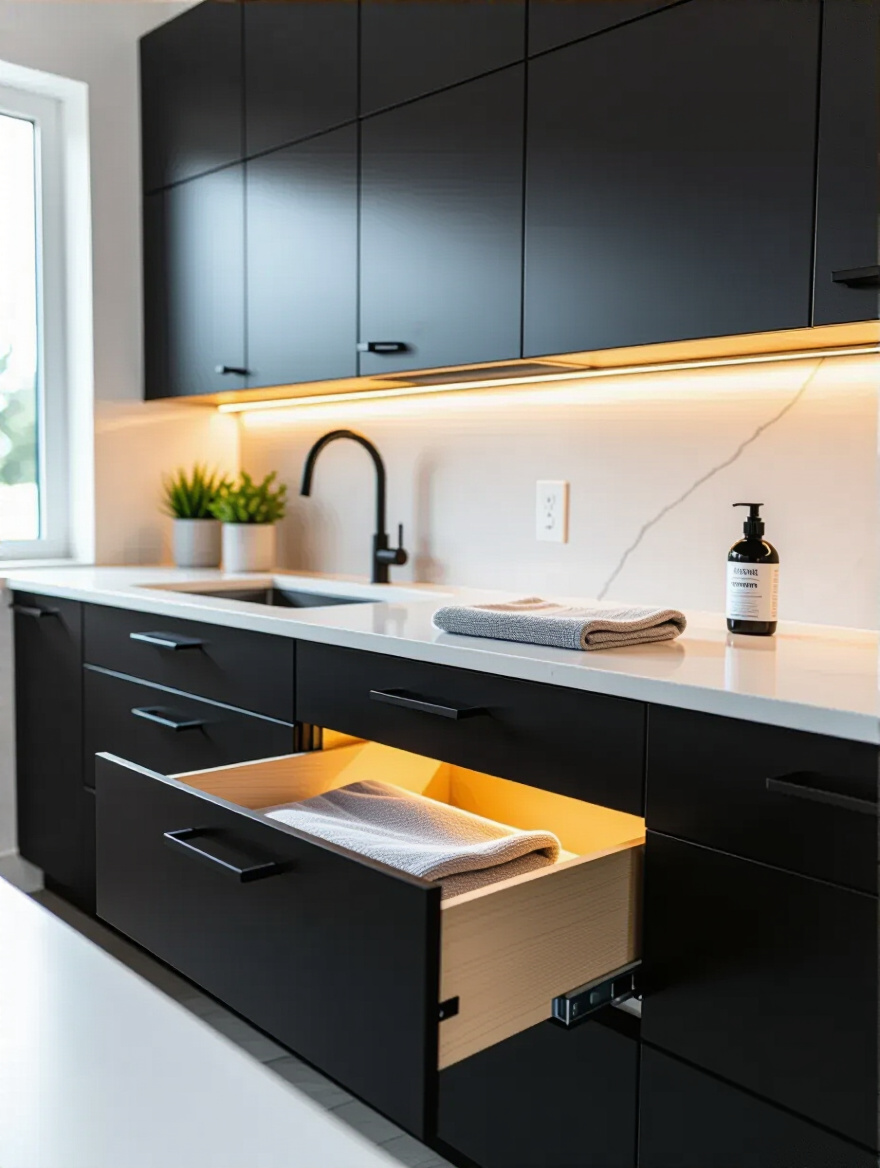
The moment you see a small scratch, you can dab a tiny bit of color on it, and poof—it’s gone. It takes ten seconds, but it prevents that little imperfection from catching your eye every time you walk into the room. This tiny bit of proactive maintenance will keep your cabinets looking brand new for years and save you from a much bigger refinishing job down the road. Also, soft-close hinges are non-negotiable—they prevent slamming that can lead to chips and damage over time.
And finally, let’s tackle the one thing that shows up on black surfaces like it’s under a spotlight.
Dust is everywhere, but on a smooth black surface, it’s the main event. While you can’t eliminate it completely, you can drastically reduce it. The biggest culprit for dust is often your HVAC system. Upgrading to a high-efficiency filter will trap way more airborne particles before they have a chance to settle on your beautiful cabinets. A small air purifier in the kitchen can also work wonders.
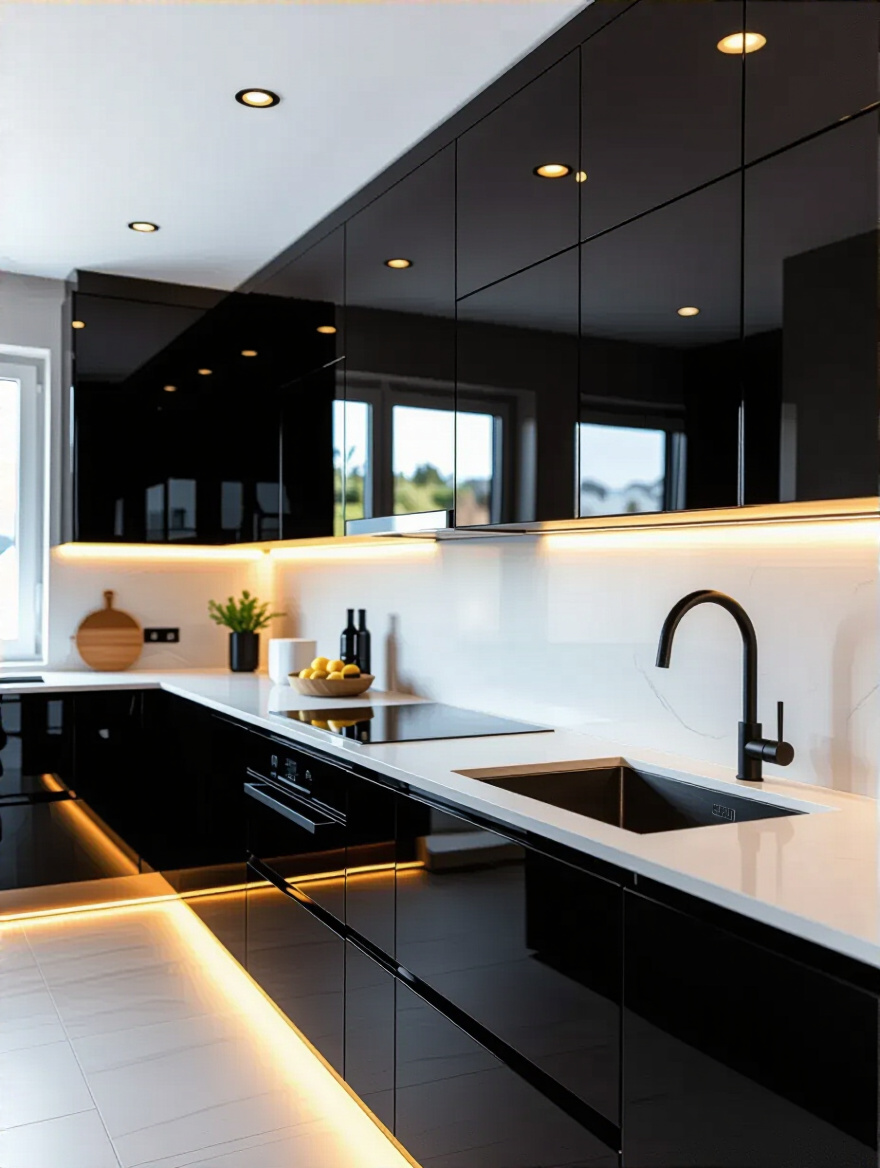
For daily maintenance, stick to your dry microfiber cloth or an electrostatic duster. These tools trap dust instead of just pushing it around. And always dust from the top down. Start with the tops of your cabinets and work your way to the counters, so any dislodged dust falls onto a surface you haven’t cleaned yet. It’s a simple change in process that makes a huge difference.
You’ve got the foundations, you’ve got the practicalities down. Now it’s time for the final layer of magic that makes your kitchen feel like a truly special, elevated space. These are the details that create mood, add character, and turn a well-designed room into an unforgettable one.
In a black kitchen, lighting isn’t just a utility; it’s a design tool. You need to think in layers. First, you have your ambient light (the “overall glow,” usually from recessed ceiling lights). Second, you have your task light (the “workhorse lights,” which are absolutely essential). This means under-cabinet lighting. It is non-negotiable. It illuminates your countertops, gets rid of shadows, and makes your backsplash sparkle.
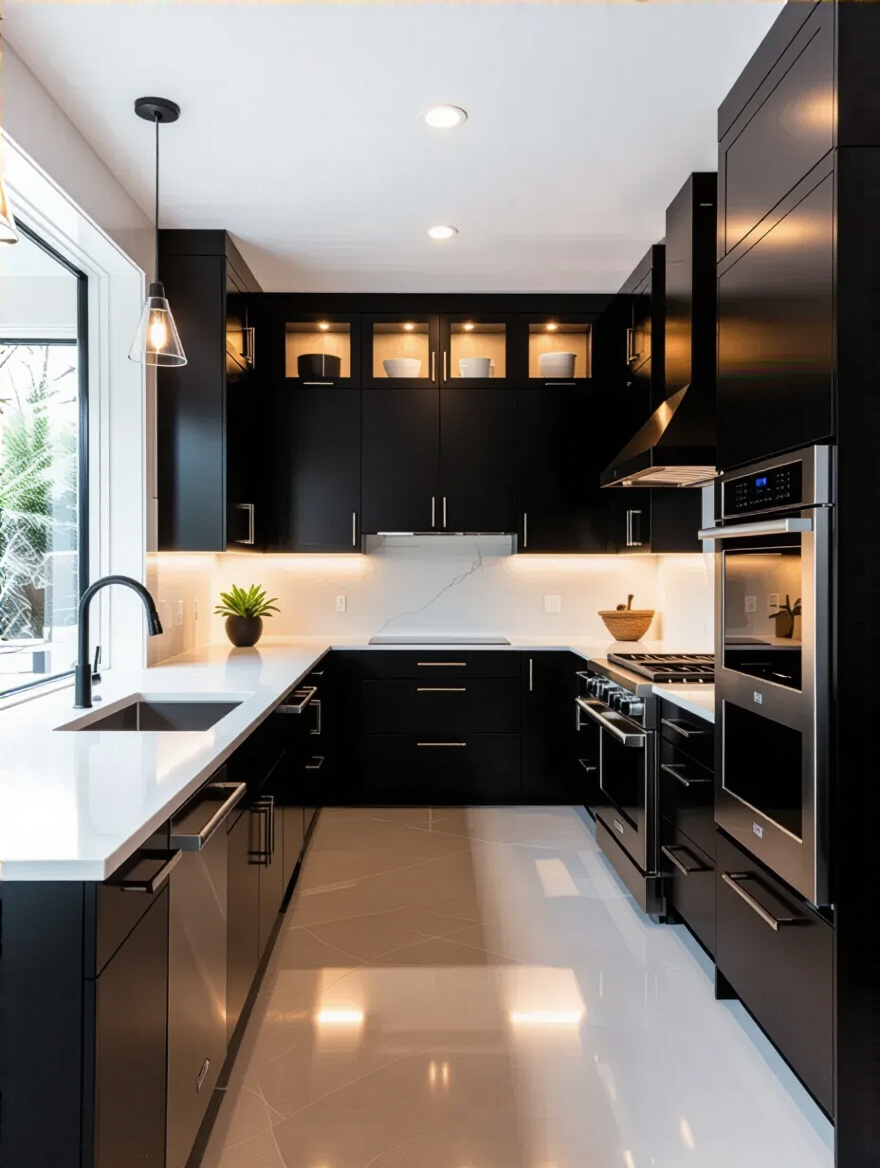
The third layer is the fun part: accent light. This is the “twinkle.” Think about putting small lights inside glass-front cabinets to make your pretty glassware glow, or even toe-kick lighting that gives your base cabinets a cool, floating effect. This layering of light creates depth, mood, and drama, ensuring your black kitchen is anything but flat.
To add a sense of lightness and a spot for personality, look to the walls.
Solid black upper cabinets can sometimes feel a bit imposing. A fantastic way to break that up is by swapping out a section of uppers for open shelving. This creates an immediate sense of lightness and airiness, giving your eye a place to rest. It’s the perfect spot to add some of that warm wood we talked about, or a sleek metal for an industrial touch.
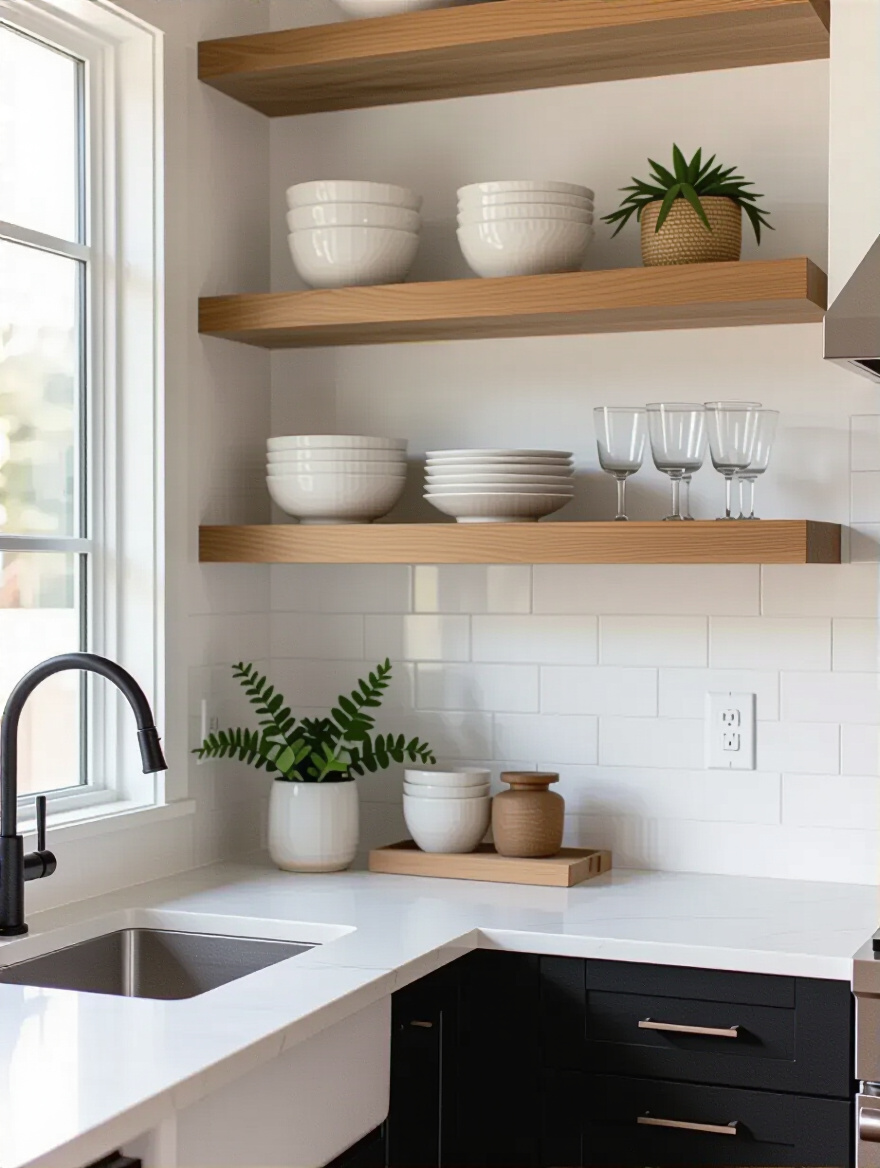
This is your curated moment. It’s not the place for your kid’s plastic cartoon-character plates. This is where you display your beautiful ceramic mugs, a few favorite cookbooks, and maybe a small plant. It adds so much personality and makes the kitchen feel more like a lived-in part of your home. Keep the everyday stuff hidden away in the closed cabinets, and let the shelves be your little art gallery.
To soften all those hard surfaces and bold colors, it’s time to bring in some life.
There is nothing that softens a bold, modern space quite like a plant. Greenery brings an organic shape, a vibrant pop of natural color, and a sense of life that is absolutely essential in a black kitchen. It keeps the design from feeling too severe or sterile and instantly makes the room feel fresher and more inviting.
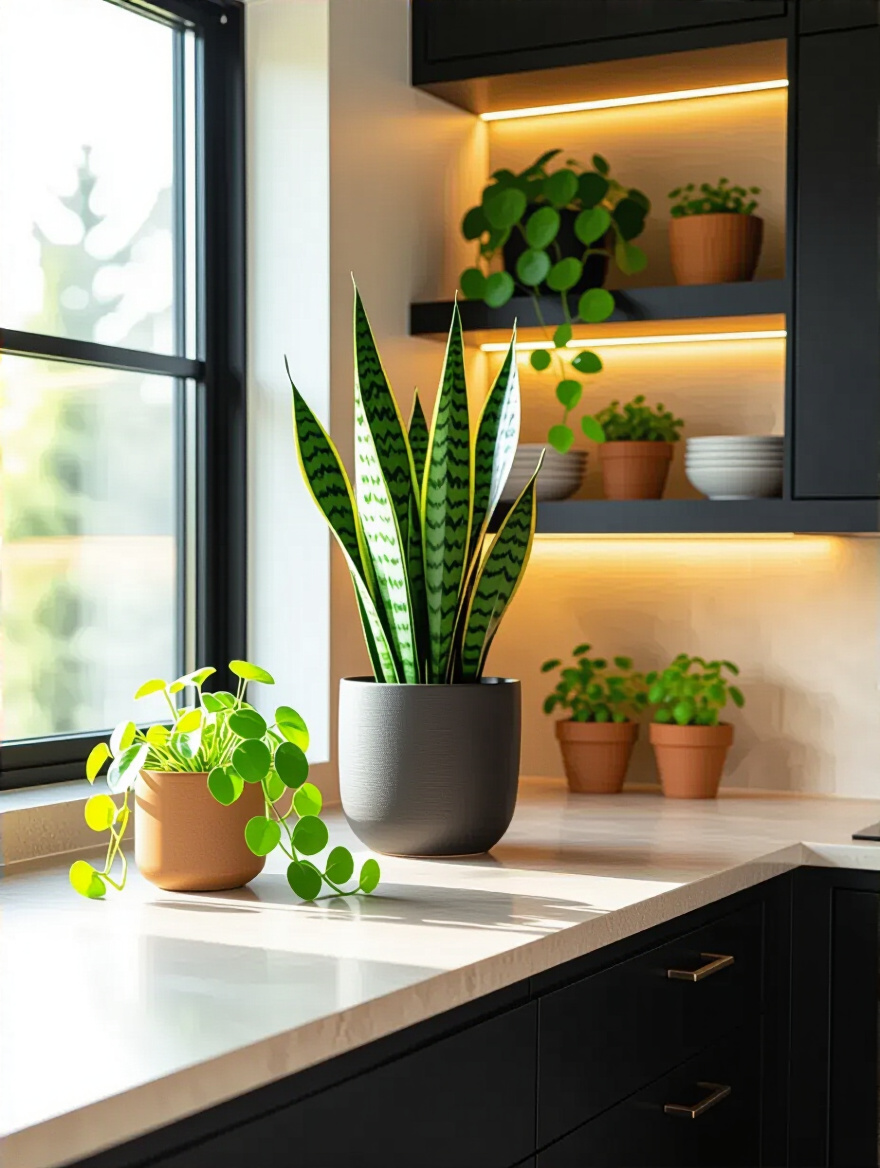
You can go big with a fiddle leaf fig tree in a corner, or keep it simple with a small pot of herbs on the windowsill. A trailing pothos on an open shelf adds beautiful movement. It’s also a wonderful way to involve your kids—give them the job of watering the “kitchen plant.” It adds a touch of nature and a dose of happy, calming energy right where you need it most.
And for the final touch of sleek sophistication…
If you’re aiming for that truly high-end, minimalist look, integrating your appliances is the ultimate power move. This means getting “panel-ready” appliances (like your fridge and dishwasher) that can be fitted with a custom front that perfectly matches your black cabinetry. The appliance literally disappears into the wall of cabinets.
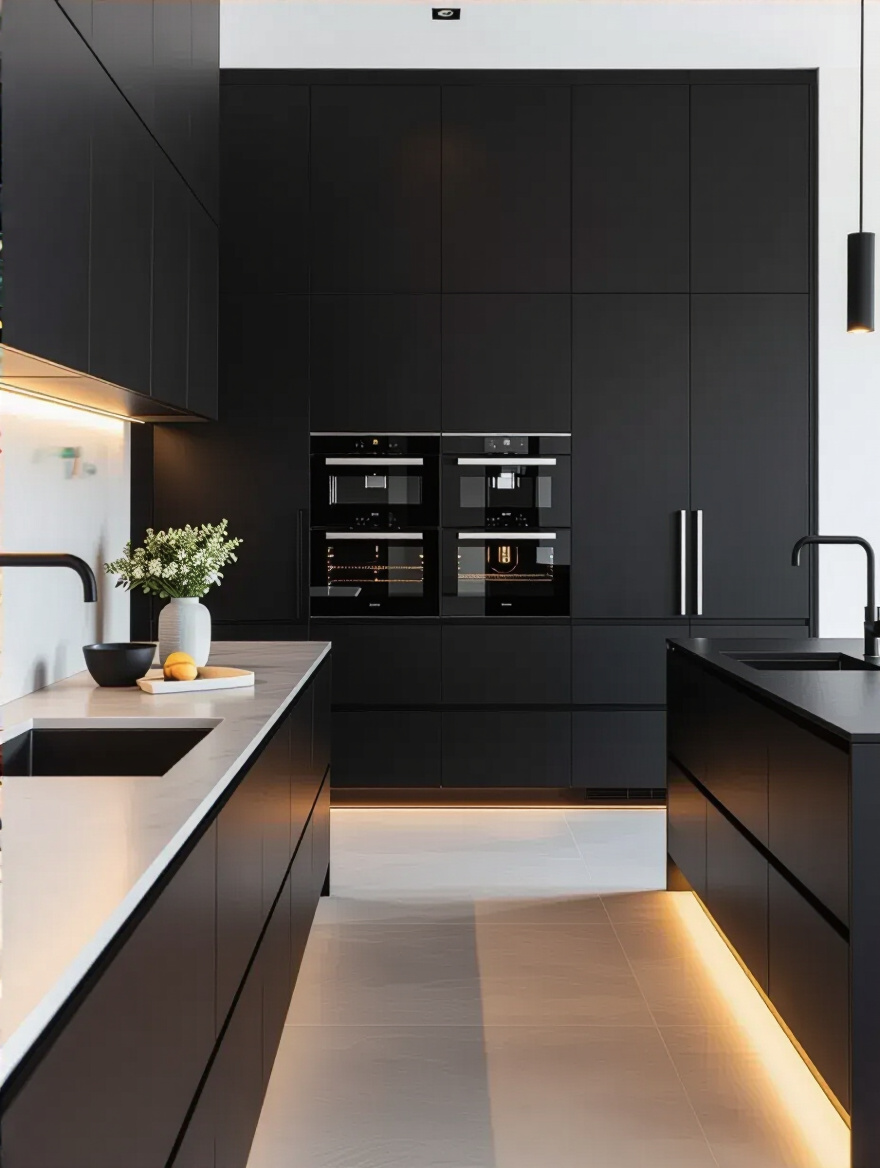
This creates an incredibly seamless, uninterrupted look that makes the entire kitchen feel more like a piece of custom furniture than a utility space. For appliances that can’t be hidden, like your oven, choose finishes like matte black or black stainless steel that will blend in rather than stand out. It’s a splurge, for sure, but the result is a breathtakingly cohesive and architectural space. My favorite pro-tip is to create an “appliance garage”—a cabinet with a lift-up or pocket door—to hide the toaster and coffee maker, keeping those countertops completely clear.
So, can you really have a dramatic, sophisticated black kitchen with a family? Absolutely. The key isn’t to be afraid of the bold choice, but to embrace it with a smart plan. It’s all about the art of balance—pairing dark with light, sleek with textured, and bold with soft. By choosing forgiving finishes, layering in warmth with wood and metallics, and harnessing the power of light, you can create a space that is not only stunningly beautiful but also incredibly functional and welcoming for everyone.
Think of your black cabinets as the perfect, elegant “little black dress” for your home. It’s timeless and chic on its own, but it’s the accessories—the lighting, the hardware, the bursts of life from plants and people—that truly make it yours. Now you have the secrets to making it work. So go on, embrace the drama. You’ve got this.